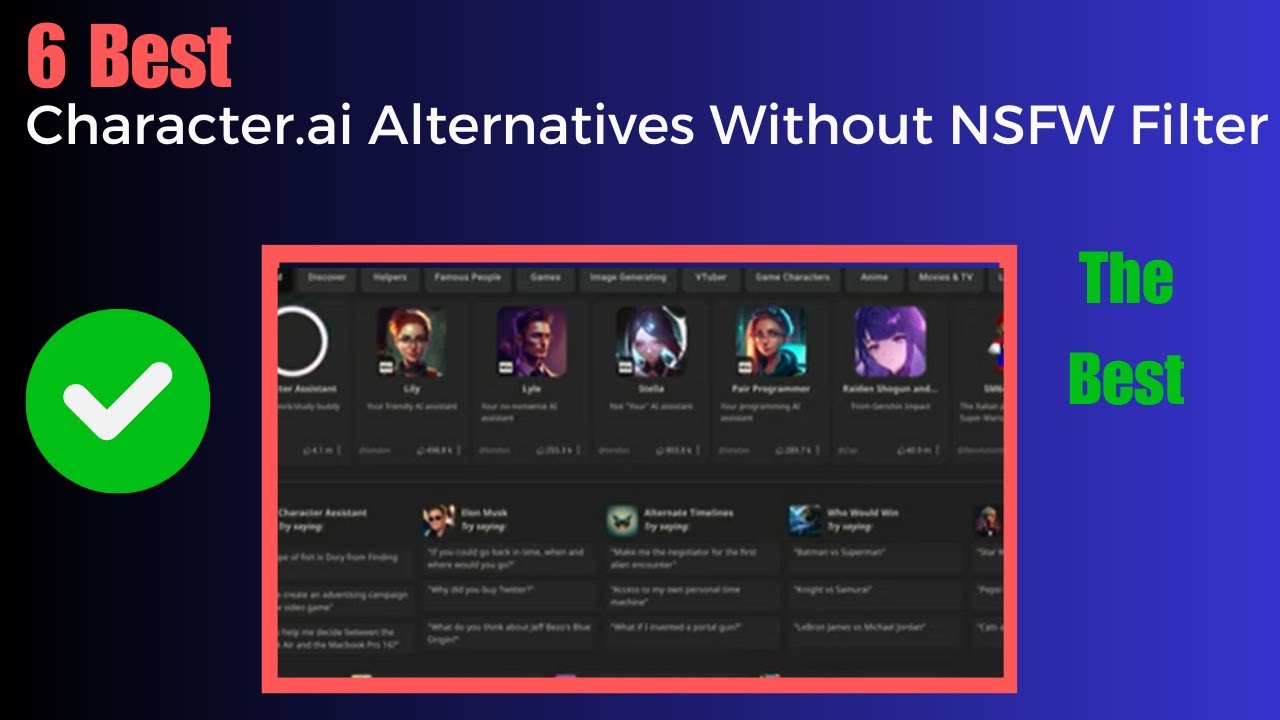
In the realm of artificial intelligence (AI), the spotlight often shines on applications like natural language processing, image recognition, and autonomous vehicles. However, one fascinating area that deserves more attention is Character AI – the technology behind creating dynamic and lifelike characters in virtual environments. As virtual worlds become more immersive and interactive, the demand for believable characters has surged, prompting developers to explore innovative alternatives to traditional character design. In this article, we delve into the realm of Character AI alternatives, exploring their significance, applications, and potential impact on various domains.
Character AI refers to the algorithms and techniques used to imbue virtual characters with traits, personalities, and behaviors that mimic human-like interactions. Traditionally, character development in video games, simulations, and virtual reality (VR) relied heavily on scripted dialogues and predefined actions. However, advancements in AI have paved the way for more dynamic and responsive characters that can adapt to player interactions and environmental stimuli.
One notable alternative in Character AI is the emergence of machine learning algorithms for personality simulation. These algorithms analyze vast datasets of human behavior to generate realistic personalities for virtual characters. By leveraging techniques such as natural language processing and sentiment analysis, these characters can engage in meaningful conversations, express emotions, and evolve based on their interactions with users.
One prominent example of machine learning-driven character AI is the use of recurrent neural networks (RNNs) to create chatbots with diverse personalities. These chatbots, often integrated into virtual environments and social simulations, can engage users in conversations that feel authentic and dynamic. By continuously learning from user interactions, they can adapt their responses and behaviors over time, enhancing the overall immersion and realism of the virtual world.
Another intriguing avenue in Character AI is the application of generative adversarial networks (GANs) for character creation. GANs, known for their ability to generate realistic images and textures, have been leveraged to design virtual characters with diverse appearances and expressions. By training GANs on large datasets of human faces and body structures, developers can create a vast array of unique characters that possess visual realism and individuality.
Furthermore, researchers are exploring the integration of affective computing techniques into Character AI to imbue virtual characters with emotional intelligence. Affective computing focuses on recognizing and interpreting human emotions, allowing virtual characters to perceive and respond to users’ emotional states. Through techniques such as facial recognition, voice analysis, and physiological sensors, virtual characters can adapt their behaviors and expressions to mirror the emotional cues of their users, fostering deeper connections and engagement.
The applications of Character AI alternatives extend beyond entertainment and gaming, finding relevance in fields such as education, therapy, and customer service. In educational simulations, dynamically generated characters can serve as interactive tutors, providing personalized feedback and guidance to learners. Similarly, in therapeutic applications, virtual characters equipped with empathetic capabilities can support individuals dealing with mental health challenges, offering companionship and assistance in coping strategies.
Moreover, in the realm of customer service and virtual assistants, Character AI alternatives offer opportunities to enhance user experiences and streamline interactions. By deploying virtual characters with natural language understanding and emotional intelligence, companies can create more engaging and empathetic customer service representatives, capable of understanding and addressing customer needs with greater effectiveness.
The adoption of Character AI alternatives also raises important ethical considerations, particularly concerning privacy, bias, and user consent. As virtual characters become more sophisticated in their interactions, there is a need to ensure transparency and accountability in how user data is collected, analyzed, and utilized. Additionally, developers must mitigate biases inherent in AI algorithms to prevent unintended discrimination or reinforcement of harmful stereotypes.
Furthermore, ensuring user consent and agency in interactions with virtual characters is paramount to respecting individuals’ autonomy and well-being. Users should have the ability to control the level of engagement with virtual characters, including the option to opt-out of certain interactions or modify their preferences regarding data sharing and personalization.
Conclusion
Character AI alternatives represent a paradigm shift in how virtual characters are conceived, designed, and implemented in digital environments. By harnessing machine learning, affective computing, and generative techniques, developers can create immersive and engaging experiences that blur the lines between reality and virtuality. However, as we venture further into this territory, it is essential to uphold ethical principles and prioritize user empowerment and well-being in the development and deployment of Character AI technologies. Only by doing so can we unlock the full potential of virtual characters as companions, educators, and partners in our digital journeys.









